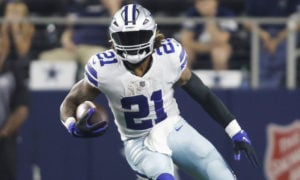Building through the Draft: A Case Study, Part Two
As I mentioned in part one of this series, I have gone back and forth on the best use for draft picks. Is it better to make the picks and hope they turn out or is it better to trade them away for players who have shown something already in the NFL. While I’m not sure I can fully answer that, I decided to do a little investigation into exactly how often a draft pick turns into a fantasy starter to help myself and all of you be as informed as possible. The results of the general examination in part 1 showed that only about a fourth of all first and second round draft picks are actually “hits.” This is much lower than I expected.
I went back through the 2013-2017 draft classes and broke all of the players down into one of the following categories:
Stud: The name says it all. These players are the cream of the crop and what we hope every draft pick will become when we make those picks. These players are top 10 if not top 5 at their position multiple years in a row.
Starter: While these players might not be the best of the best, they are still likely to be an every week starter on most fantasy teams. For this examination, they needed to be at this level for multiple years.
Backup: These players are definitely on rosters, but they are nothing more than a spot starter, flex play, or an injury fill in. In a few cases they are players who have had one good year, but they haven’t been consistent enough to be counted upon.
Bust: Many of these players are out of the league. If they are still in the league, they have shown so little that they are often on the waiver wire or barely hanging on to the end of the bench spots in leagues.
In part two, I’m going to break this data down a little bit more to see what I can uncover in terms of draft position. Maybe there will be some trends and patterns we can use to our advantage when it comes to drafting. With that said, lets start breaking things down in a few different ways to see what we can find.
First vs Second Round Picks
Total: 60 picks for each round
First Round Studs: 12 Players or 20 percent of the time
First Round Starters: 9 Players or 15 percent of the time
Second Round Studs: 6 Players or 10 percent of the time
Second Round Starters: 5 Players or 8.3 percent of the time
As conventional wisdom would suggest, first round picks have a higher hit rate than second round picks. In fact, they hit about twice as often as the second round picks. First round picks hit at just over a third of the time while second round picks are a touch under one out of every five picks hitting. Lets break it down a little bit further. For the rest of the article, I’ll consider the studs and starters as both being “hits” in terms of the draft pick.
Early, Middle and Late First Round Hits
[am4show have=’g1;’ guest_error=’sub_message’ user_error=’sub_message’ ]
Total: 12 studs and 9 starters
First 4 picks: 6 of the 12 studs (50 percent) and 5 of the 9 starters (55 percent). 11 out of the 20 players or 55 percent hit overall.
Middle 4 picks: 4 of the 12 studs (33 percent) and 2 of the 9 starters (22 percent). 6 out of the 20 players or 30 percent hit overall.
Last 4 picks: 2 of the 12 studs (17 percent) and 3 of the 9 starters (33 percent). 5 out of the 20 players or 25 percent hit overall.
While I’m sure we all expected the early first round to be the most productive part of the round, I was a little surprised that the first four picks were almost twice as productive when it comes to the overall hit rate at the rest of the first round. The middle and later parts of the first had very similar hit rates with the middle producing slightly better quality when it hits than the last part of the round.
Early, Middle and Late Second Round Hits
Total: 6 studs and 5 starters
First 4 picks: 2 of the 6 studs (33 percent) and 3 of the 5 starters (60 percent). 5 out of the 20 players or 25 percent hit overall.
Middle 4 picks: 1 of the 6 studs (17 percent) and 2 of the 5 starters (40 percent). 3 out of the 20 players or 15 percent hit overall.
Last 4 picks: 3 of the 6 studs (50 percent) and 0 of the 5 starters (0 percent). 3 out of the 20 players or 15 percent hit overall.
While the first round distribution made a lot of sense, the second round is a bit more scattered. Over the five years of the sample, half of the studs came from the last few picks of the round while the majority of the hits came from the first part of the round. This will be explained a little bit more in the positional breakdown in part three. The more important piece is the 15 percent hit rate for all but the first part of the second round. This is a pretty terrible return rate. I know some of us like to think we can be better than the norm, but the question is how much better? Even if you are twice as good as the norm, that is still less than one out of every three draft picks for the middle and later parts of the second round on any given year.
Later Rounds
I’m not going to break down the later rounds quite as closely as I did the first two rounds. The reason is that it really isn’t needed. If you start looking at players who were drafted in the third round or later in rookie drafts it is for the most part a wasteland of players. For example, if you look at the 2016 rookie draft, out of the 24 players who were drafted in the third or fourth rounds in most rookie drafts I see only a single player I would consider a hit, Stefon Diggs. You could maybe make an argument for Jamison Crowder, but a career best line of 67 receptions, 847 yards and 7 scores really means he is more of a flex play than an every week starter. That means we are talking about one hit in 24 picks or a miserable 4 percent hit rate.
The 2016 draft class isn’t really an exception. The 2017 draft class might have only a single hit if things work out for Austin Hooper. The 2015 draft class might have as many as three players with Jarvis Landry, Derek Carr, and Jerick McKinnon. However, McKinnon hasn’t proven anything yet and Carr might be a bit of a stretch to fit into the hit category at this point in time. The 2018 draft class looks a little better due to our optimistic nature and how we view potential, but even the most optimistic of us might only project seven or eight hits out of the 24 players, the majority of which come from the quarterback or tight end positions. That means even with the best case for the 2018 draft class, this five year time period about a 10 percent hit rate in those later rounds. Keep in mind, this is the best case and likely inflated quite a bit by the 2018 draft class. The majority of the years feature less than a 5 percent hit rate in those later rounds.
Conclusion for Draft Position
As we would all expect, the draft position has a lot to due with the success rate of our draft picks. However, I was pretty surprised at how draft a difference it makes. I was expecting the first round to be about a 50 percent hit rate with the second round being about a 33 percent hit rate. This was way too optimistic on my part as both numbers were about double what reality actually is when you break down these draft classes. This doesn’t paint a very pretty picture when it comes to building through the draft. I know some of you pride yourselves on your ability to uncover those hidden gems in drafts, but try taking an objective look at your draft record. The numbers for the average person really don’t look very good.
In the third and final part of this little hunt through the recent draft classes, I’ll work on breaking things down by position to see what we can learn.
- Final 2021 Pre-Draft Rookie Mock: Round Three - April 28, 2021
- Final 2021 Pre-Draft Rookie Mock: Round Two - April 26, 2021
- Final 2021 Pre-Draft Rookie Mock: Round One - April 25, 2021


































































